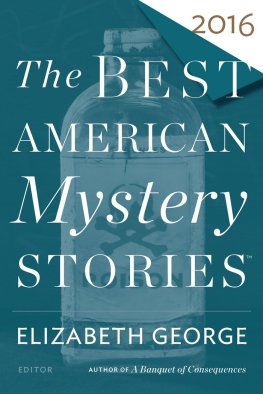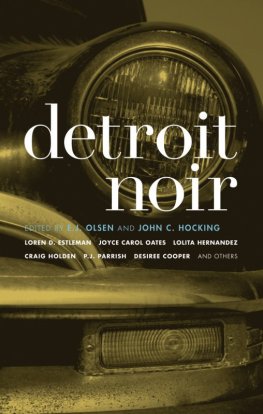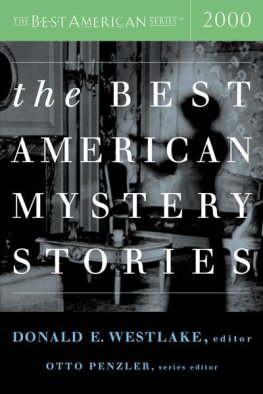The Best American Mystery Stories 2016
(Edited and with an Introduction by Elizabeth George
Otto Penzler, Series Editor)
The Little Men by Megan Abbott. First published by Bibliomysteries, Mysterious Press, September 15, 2015. Copyright 2015 by Megan Abbott. Reprinted by permission of Megan Abbott.
Okay, Now Do You Surrender? by Steve Almond. First published in Cincinnati Review, vol. 11, no. 2. Copyright 2015 by Steve Almond. Reprinted by permission of Steve Almond.
Toward the Company of Others by Matt Bell. First published in Tin House, issue 65. Copyright 2015 by Matt Bell. Reprinted by permission of Matt Bell.
Fool Proof by Bruce Robert Coffin. First published in Red Dawn: Best New England Crime Stories. Copyright 2015 by Bruce Robert Coffin. Reprinted by permission of Bruce Robert Coffin.
Safety by Lydia Fitzpatrick. First published in One Story, issue 207. Copyright 2015 by Lydia Fitzpatrick. Reprinted by permission of Georges Borchardt, Inc., on behalf of the author.
Christians by Tom Franklin. First published in Murder under the Oaks, edited by Art Taylor. Copyright 2015 by Tom Franklin. Reprinted by permission of Tom Franklin.
A Death by Stephen King. First published in The New Yorker, March 9, 2015. From The Bazaar of Bad Dreams by Stephen King. Copyright 2015 by Stephen King. Reprinted with the permission of Scribner, a division of Simon & Schuster, Inc. All rights reserved.
For Something to Do by Elmore Leonard. First published in Charlie Martz and Other Stories: The Unpublished Stories of Elmore Leonard. Copyright 2015 by Elmore Leonard, Inc. Reprinted by permission of HarperCollins Publishers.
The Continental Opposite by Evan Lewis. First published in Alfred Hitchcocks Mystery Magazine, May 2015. Copyright 2015 by David Evan Lewis. Reprinted by permission of Evan Lewis.
Street of the Dead House by Robert Lopresti. First published in nEvermore! edited by Nancy Kilpatrick and Caro Soles, July 1, 2015. Copyright 2015 by Robert Lopresti. Reprinted by permission of Robert Lopresti.
Laffertys Ghost by Dennis McFadden. First published in Fiction, no. 61. Copyright 2015 by Dennis McFadden. Reprinted by permission of the author.
The Tank Yard by Michael Noll. First published in Ellery Queens Mystery Magazine, July 2015. Copyright 2015 by Michael Noll. Reprinted by permission of Michael Noll.
Trash by Todd Robinson. First published in Last Word by the editors of Joyride Press, August 2015. Copyright 2015 by Todd Robinson. Reprinted by permission of Todd Robinson.
Christmas Eve at the Exit by Kristine Kathryn Rusch. First published in Ellery Queens Mystery Magazine, January 2015. Copyright 2015 by Kristine K. Rusch. Reprinted by permission of Kristine K. Rusch.
The Mountain Top by Georgia Ruth. First published in Fish or Cut Bait: A Guppy Anthology, April 7, 2015. Copyright 2015 by Georgia Wilson. Reprinted by permission of Georgia Wilson.
Mailman by Jonathan Stone. First published in Cold-Blooded, edited by Clay Stafford and Jeffery Deaver, October 27, 2015. Copyright 2015 by Jonathan Stone. Reprinted by permission of Jonathan Stone.
Rearview Mirror by Art Taylor. First published in On the Road with Del & Louise by Art Taylor, September 15, 2015. Copyright 2015 by Art Taylor. Reprinted by permission of Henery Press, LLC.
Border Crossing by Susan Thornton. First published in the Literary Review, vol. 58, no. 3, Summer 2015. Copyright 2015 by Susan R. Thornton. Reprinted by permission of Susan R. Thornton.
Entwined by Brian Tobin. First published in Alfred Hitchcocks Mystery Magazine, June 2015. Copyright 2015 by Brian Tobin. Reprinted by permission of Brian Tobin.
Gods Plan for Dr. Gaynor and Hastings Chiume by Saral Waldorf. First published in Southern Review, Spring 2015. Copyright 2015 by Saral Waldorf. Reprinted by permission of Saral Waldorf
This is the twentieth edition of The Best American Mystery Stories of the year, a very gratifying milestone. The series began when my agent, Nat Sobel, and I were having lunch, as we have every month for the past thirty years. In the middle of a sentence about who knows what he said, I have an idea. This is common in our relationship, as I would argue that he is the best and most creative agent on the planet.
Nat had represented the longtime series editor of Houghton Mifflins prestigious The Best American Short Stories of the year, an annual event that began in 1915. He suggested that it was time for a similar mystery series and thought I should be the editor. I agreed. He went back to his office, called the editor in chief of Houghton Mifflin, and they came to an agreement in two minutes.
For my first guest editor, I wanted someone who was an accomplished author, not just in the mystery category but one who brought serious literary credentials to the table as well. Being a bestseller was not a requirement but was certainly a desirable element. I aimed high and called my friend Robert B. Parker, who agreed to take on the job without hesitation. To this day, his introduction to the 1997 edition remains the most erudite and comprehensive essay in the history of the series. The book went on to make the bestseller list in Boston and sold enough copies nationally to make Houghton Mifflin happy.
Reflecting on the past twenty years reminds me of how much has changed but also how much has remained the same.
Changes? The publisher is now Houghton Mifflin Harcourt, following a merger of these two honored houses, both with long histories of excellence. The editor in chief has changed twice during those two decades. The publishing landscape has changed, with more and more mergers, though there is less impact on readers than one might have expected. The bookselling landscape has changed even more. Twenty years ago, Amazon was just beginning to emerge as a major force; today it dominates the bookselling world. Whereas the giant book emporiums of Barnes & Noble and Borders had forced many independent bookshops out of business, the marketplace dominance of Amazon has forced Borders out of existence and seriously threatens Barnes & Noble, while further crippling the independent bookstore. The ray of light is that more independent bookstores have opened in America during the past three years than closed their doors.
Similarities? I am still the series editor, and the methodology of determining which stories make the cut remains the same. My invaluable associate Michele Slung reads and evaluates thousands of stories every year, culling those that clearly do not belong on a short list or a long one either, for that matter to determine if they have mystery or criminal content, frequently impossible to know merely by reading the title, as well as whether they have any literary merit. I then read the stories that need to be considered in order to arrive at the fifty best (or at least those I like the most). Those are sent to the guest editor, who selects the twenty stories that make it into the book; the remaining thirty receive honorable mention. The best writing makes it into the book. Fame, friendship, original venue, reputation, subject none of it matters. It isnt only the qualification of being the best writer that will earn a spot in the table of contents; it also must be the best story.
Another similarity from the first book to the twentieth has been the quest to have the right person serve as the guest editor. Willingness to do this is an act of generosity. Every guest editor for this series has been a national bestseller, and therefore these are authors who are asked to do something virtually every day of their lives: write a story, make a speech, sign a book, visit a bookshop or library, provide a quote for a dust jacket, offer advice about how to be a better writer or a more successful one, attend a conference or convention the list goes on.

















